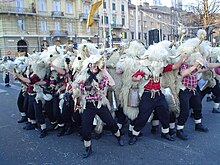Zvončari
- View a machine-translated version of the Croatian article.
- Machine translation, like DeepL or Google Translate, is a useful starting point for translations, but translators must revise errors as necessary and confirm that the translation is accurate, rather than simply copy-pasting machine-translated text into the English Wikipedia.
- Do not translate text that appears unreliable or low-quality. If possible, verify the text with references provided in the foreign-language article.
- You must provide copyright attribution in the edit summary accompanying your translation by providing an interlanguage link to the source of your translation. A model attribution edit summary is
Content in this edit is translated from the existing Croatian Wikipedia article at [[:hr:Zvončari]]; see its history for attribution. - You may also add the template
{{Translated|hr|Zvončari}}to the talk page. - For more guidance, see Wikipedia:Translation.
 Zvončari at the Rijeka Carnival | |
| Place of origin | Primorje-Gorski Kotar County, Croatia |
|---|---|
| Annual carnival bell ringers’ pageant from the Kastav area | |
|---|---|
| Country | Croatia |
| Reference | 00243 |
| Region | Europe and North America |
| Inscription history | |
| Inscription | 2009 (4th session) |
| List | Representative |
Zvončari ("bellmen") is the characteristic folk custom maintained in the region around Rijeka, Croatia. It was added to UNESCO's Representative List of the Intangible Cultural Heritage of Humanity in 2009.[1]
The custom dates to Slavic pagan antiquity and remains typical for this region. The primary task of Zvončari is to scare away evil spirits of winter and to stir up a new spring-time cycle. During the Rijeka Carnival, Zvončari march from village to village throughout the region, following the same centuries-old route, making an extraordinary amount of noise, fueled in part by the wine provided by the locals' en route.
Description

The standard Zvončar costume includes white trousers, striped shirt, and a sheepskin throw. In their hands they hold a "balta" or "bačuka" — a stylized mace, and around the waist one or more big brass bells. The costume varies from village to village; for example, Zvončari of Halubje and Grobnik (Dondolaši) wear special stylized masks representing fantastic animal heads, while Zvončari of Žejane (populated by Istro-Romanians) and Brgud [hr] wear "flower hats". Local legend claims that it was the Zvončari that scared away invading Tatars or Turks during the Ottoman conquest, with shepherds doning masks on their heads, along with belted-on bells, produced a deafening noise that scared the enemy away. From that time on, a mace became part of the standard equipment of Zvončari.[2]
The Zvončari participate regularly in the international Rijeka Carnival.
See also
References
External links

- Zvončari of Halubje
- Dondolaši of Grobnik
- Rijeka Carnival
- v
- t
- e
- Festival of Saint Blaise
- Two-part singing and playing in the Istrian scale
- Klapa multipart singing of Dalmatia, southern Croatia
- Lacemaking in Croatia
- Gingerbread craft from Northern Croatia
- Međimurska popevka, a folksong from Međimurje
- Nijemo kolo, silent circle dance of the Dalmatian hinterland
- Bećarac singing and playing from Eastern Croatia
- Sinjska alka, a knights’ tournament in Sinj
- Spring procession of Ljelje/Kraljice (queens) from Gorjani
- Traditional manufacturing of children’s wooden toys in Hrvatsko Zagorje
- Procession Za križen (‘following the cross’) on the island of Hvar
- Annual carnival bell ringers’ pageant from the Kastav area
- Festivity of Saint Tryphon and the Kolo (chain dance) of Saint Tryphon, traditions of Croats from Boka Kotorska (Bay of Kotor) who live in the Republic of Croatia
- Mediterranean diet
- Art of dry stone walling, knowledge and techniques
- Transhumance, the seasonal droving of livestock
- Lipizzan horse breeding traditions
- Falconry, a living human heritage
Safeguarding
- Ojkanje singing
Practices
- Community project of safeguarding the living culture of Rovinj/Rovigno: the Batana Ecomuseum
- Tocatì, a shared programme for the safeguarding of traditional games and sports
 | This Croatia-related article is a stub. You can help Wikipedia by expanding it. |
- v
- t
- e











